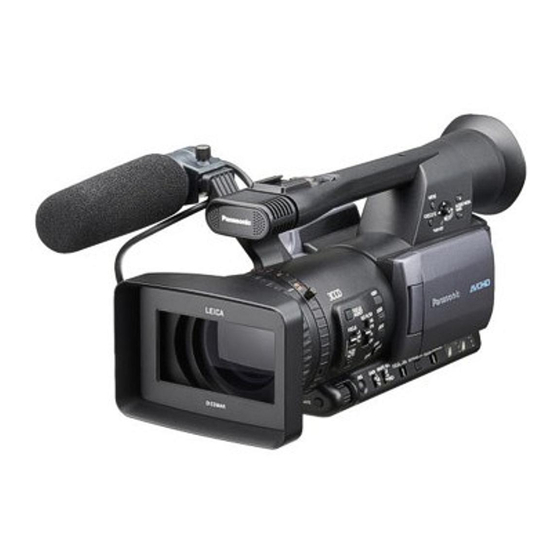H.264 (a.k.a. AVC (Advanced Video Coding),
MPEG-4 Part 10) is a high quality and efficient (yet
computer intensive) form of video compression used
in Blu-ray Disc and web video services like YouTube
and the iTunes Store. Due to its efficiency, it is being
used by a growing number of tapeless cameras for
storage of HD videos on SD cards.
HDTV. High De nition Television. A television
format with a aspect ratio of 16x9 (as opposed to the
classic 4x3) and higher resolution. Rather than a
single HDTV standard the FCC approved several
different standards, allowing broadcasters to choose
which to use. is means that HDTV television have
to support all of them. All of the systems are
broadcast as component digital. e New HDTV/
SDTV standards include: HDTV 1920 x 1080 @ 30i
or 30p or 24p frame rate with a 16 x 9 aspect ratio;
HDTV 1280 x 720 @ 60p, 30p, 24p frame rate with
a 16 x 9 aspect ratio; SDTV 720 x 483 @ 60p, 30p,
24p frame rate with a 16 x 9 aspect ratio; SDTV 640
x 480 @ 30i with a 4 x 3 aspect ratio (i = interlaced, p
= progressive, scan).
HDV. A consumer-oriented high-de nition video
format using MiniDV tapes which differs from DV
in that it uses MPEG-2 inter-frame compression in
order to encode the higher resolution needed for HD
at the same bit rate as DV using the same tape. e
use of a MPEG-2 long GOP inter-frame compression
can sometimes produce motion artifacts. HDV also
complicates the editing process since inter-frame
compression requires signi cantly more processing
power than DV since editing systems have to
reconstruct intermediate frames computationally.
HDV has been widely adopted by both consumer
and professional users who need to work with a small
and portable camera but want to produce shows that
are compatible with the newer high de nition video
standard. HDV does not implement full-resolution
high de nition, instead it records at 1440 lines (full
HD is 1920 lines). See also AVCHD, XDCAM EX,
and DVCPRO HD.
Hertz (Hz). A unit for specifying the frequency of a
signal, formerly called cycles per second (cps).
High-angle shot (H/A). A shot where the camera is
tilted down at the subject.
In-camera editing. Editing done within the camera
itself by selectively starting and stopping the camera
for each shot.
Independent lm. Any motion picture produced
outside of a commercial lm studio. e term applies
generally to avant-garde, experimental, or
Introduction to the Panasonic AG-HMC150 AVCHD camcorder (rough draft)
underground, narrative, and documentary lms made
outside of the Hollywood establishment. Often the
term implies independent vision as well as
independent nancing.
Intra-frame compression. Also called I-frame, with
this compression technique each frame (the
individual pictures that make up a movie) is
compressed separately. In other words, the video is
stored as a series of discrete pictures, and the
compressor deals with each frame independently of
the others around it. Intra-frame techniques are
usually preferable to inter-frame for editing, since it is
easier for the computer to decompress frames while
editing, but it also produces bigger le sizes and thus
may require a more hard drive storage to work with.
Examples of intra-frame formats include: DV, as well
as DVCPRO, DVCPRO HD, and ProRes 422. See
also Compression, Codec.
Inter-frame compression. When a codec uses an
inter-frame compression technique the frames are not
only compressed individually, but each frame relies
on the frames around it in order to determine the
most efficient way to encode the video. e codec
typically looks at one frame, then looks at the next to
see what's changed, and records only the changes
instead of the whole frame. Inter-frame is often used
by cameras to t more footage onto the recording
media (a tape, card, or hard disk), but is more
difficult to edit with, as the computer has to work
harder at decoding the frames. While less storage is
required, more computational power is required, and
therefore when editing inter-frame codecs newer,
faster computers are required. Examples of inter-
frame codecs include: MPEG-2, H.264, AVCHD
(H.264 codec, currently used in several tapeless
cameras like the Canon VIXIA series), and HDV
(MPEG-2 codec). See also Codec, Compression.
Interlaced scan video. A process in which the
picture is split into two elds by sending all the odd
numbered lines to eld one and all the even
numbered lines to eld two. Field one is then
displayed rst, followed by eld 2. is process was
necessary in the early days of television broadcast
when there was not enough bandwidth within a
single television channel to send a complete frame
fast enough to create a non- ickering image. Interlace
introduces a problem called interline twitter in which
areas with ne vertical detail will have a "twittering"
motion. Another artifact is "stair-stepping" on
diagonals. ese artifacts are among the reasons
professionals prefer to shoot progressive video
formats. See also Field, Frame, Progressive scan video.
http://kino-eye.com/dvb/
30 / 35

